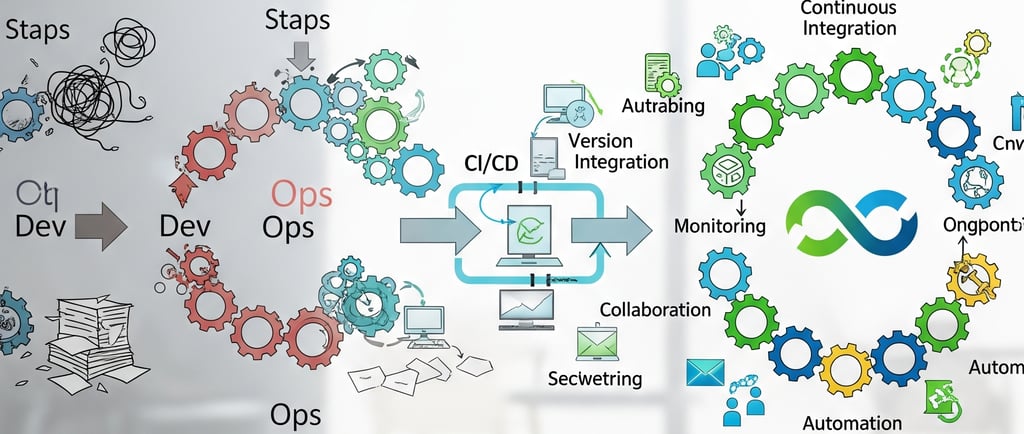The Future of AI-Driven DevOps: From Automation to Autonomy
DevOps is already the backbone of modern software delivery. We’ve moved from monthly deployments to multiple releases per day, from manual testing to automated pipelines. Yet, if we pause and look ahead, it’s clear: we’re just scratching the surface. The next frontier is not merely automating workflows, but building autonomous DevOps ecosystems—AI-powered systems that can sense, decide, and act faster than humans ever could.
Voruganti Kiran Kumar
8/5/20223 min read


DevOps is already the backbone of modern software delivery. We’ve moved from monthly deployments to multiple releases per day, from manual testing to automated pipelines. Yet, if we pause and look ahead, it’s clear: we’re just scratching the surface. The next frontier is not merely automating workflows, but building autonomous DevOps ecosystems—AI-powered systems that can sense, decide, and act faster than humans ever could.
A Quick Look Back: The Evolution of DevOps
To understand where we’re headed, let’s reflect briefly on how far we’ve come:
2000s – Early Automation: Shell scripts, cron jobs, and rudimentary monitoring.
2010s – CI/CD Boom: Tools like Jenkins, GitLab CI, and CircleCI standardized continuous integration and delivery.
2020s – Cloud-Native & AI Monitoring: Kubernetes, microservices, and AIOps brought predictive insights and anomaly detection.
Each decade reduced manual intervention and increased speed + reliability. But today’s systems are still largely reactive—waiting for humans to set rules, define scripts, or approve deployments.
The Leap: From Automation to Autonomy
Here’s where things get exciting. AI-Driven DevOps goes beyond pre-defined automation:
Predictive Scaling
Imagine an e-commerce platform that forecasts Black Friday surges weeks in advance, automatically provisioning cloud capacity before the spike.Self-Healing Pipelines
An AI system that notices latency creeping up, diagnoses the root cause, and rolls back or patches on its own—no 3 A.M. on-call needed.Intelligent Release Optimization
Algorithms that analyze past deployments across thousands of orgs to recommend the safest, fastest, and most reliable release strategies.Continuous Learning Agents
Pipelines that don’t just run code—they learn. Every deployment makes them smarter, every failure makes them more resilient.
This is not science fiction. Early prototypes are already here in AIOps platforms, anomaly detection engines, and reinforcement learning-based optimization.
Why Autonomy Matters
Shifting to AI-driven autonomy isn’t just an incremental improvement. It has transformational value:
Speed at Scale: Enterprises can ship updates 10x faster with 70–80% fewer failures.
Resilience by Default: Outages are prevented rather than mitigated.
Cost Savings: Smarter use of cloud resources can cut expenses by 20–40%.
Human Capital Reimagined: Engineers move from firefighting → innovating, solving higher-order problems.
When companies save millions per year while reducing burnout, it’s not just a technical advantage—it’s a strategic differentiator.
The Challenges Ahead
But autonomy also raises tough questions:
Trust: Can enterprises trust AI to make life-or-death decisions about uptime, compliance, or customer data?
Governance: Who is accountable when AI makes the wrong call—vendors, engineers, or executives?
Bias & Explainability: Models must not only work but also justify why they acted a certain way.
Cultural Resistance: Many engineers fear being replaced rather than augmented by AI.
These challenges won’t vanish overnight, but the organizations that experiment early will define the governance frameworks others follow.
My Vision: The Autonomous DevOps Agent
I believe that by 2030, most Fortune 500 companies will run on autonomous DevOps agents—AI copilots that:
Continuously learn from global deployment data.
Optimize across cost, speed, and resilience.
Collaborate with human engineers by providing explainable recommendations.
This won’t eliminate humans. It will redefine the human role: from operators of pipelines to strategic architects of intelligence-driven ecosystems.
What Can You Do Today?
For CTOs, DevOps leaders, and AI innovators, here’s how to prepare:
Experiment with AIOps: Start small with AI-powered anomaly detection or intelligent log analysis.
Build AI Literacy: Train teams not just on tools but on ML fundamentals, so they can trust and challenge AI outputs.
Track Metrics That Matter: Focus on latency reduction, MTTR (Mean Time to Recovery), and cost per deployment—because these are the KPIs AI will supercharge.
Partner Early: Collaborate with AI vendors, research labs, and open-source projects shaping this space.
The next five years are the incubation period. The companies that start building AI-DevOps DNA today will be tomorrow’s market leaders.
Final Thoughts
The future of DevOps isn’t just about doing things faster—it’s about doing them smarter, safer, and with foresight. As AI matures, the boundaries between human judgment and machine intelligence will blur, creating a new era of trustworthy autonomous systems.
The real question is not if DevOps will become autonomous, but when.
Call to the Community
I’d love to hear from fellow leaders:
Do you trust AI to run mission-critical deployments today?
What would help you feel confident adopting autonomous DevOps agents?
Let’s build the conversation together. Because the future isn’t waiting—it’s already being deployed.